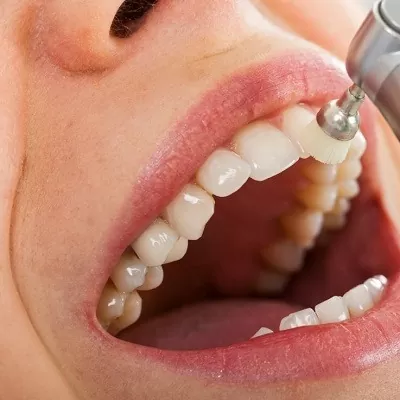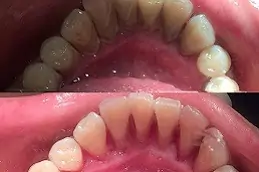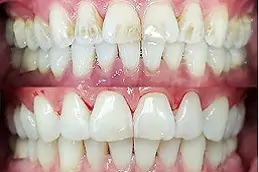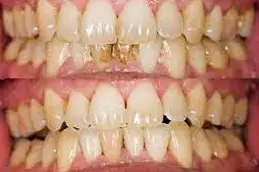Results:
Professional oral hygiene allows not only to eliminate tartar but also to restore of the primary shine and colour of the teeth. After all stages of the procedure, your teeth become clean, and healthy and receive strengthening therapy and long-term protection.
Ideal Candidate:
The best candidate for the treatment is someone having the following conditions:
- Accumulation of tartar, hard plaque on the enamel
- People who regularly drink strong tea and coffee and smoke
- During cleaning, the factor that causes inflammation of the soft tissues is removed
Treatment Techniques:
Several effective methods are used for cleaning:
Ultrasonic:
Waves destroy solid fragments, and crushed fine fractions are easily removed using automatic nozzles. The effect of ultrasound is painless and safe. Manipulations do not damage hard tissues. Moreover, ultrasound disinfects the oral cavity, reducing the risk of gum disease.
Airflow:
The dental unit is used to remove plaque. It is also used for polishing crowns. Cleaning involves spraying a powerful jet of water, air, and salt mixture. Such an impact leads to the destruction of the stone. This cleaning method is very effective. The specialist chooses the intensity of exposure and the level of abrasiveness, considering the condition of the oral cavity of a particular patient.
Mechanical Teeth Cleaning in Georgia:
This method has been around for decades. And although hardware methods have appeared, dentists are not ready to give up automated techniques. This is due to the effectiveness and relative safety. With a large volume of calculus on the surface of the teeth, ultrasonic cleaning and the use of mechanical instruments significantly increase the effectiveness.
Procedure:
The stages of professional Teeth Cleaning in Georgia are as follows:
- Examination of the oral cavity. The dentist needs to assess the condition of the elements of the dentition and gums to identify the presence and extent of deposits. During the appointment, the doctor determines the optimal method of brushing your teeth, which is suitable for a particular case.
- In some cases, oral anesthesia is used, making the procedure less painful.
- To determine the boundaries of dental deposits, the doctor can use unique diagnostic methods – litmus solutions, other indicators, and dental instruments.
- Soft deposits are removed by mechanical action or using Air Flow. The specialist may suggest a combined method. Plaque is removed carefully so as not to damage the tooth enamel. A jet of air, water, and salt grains is forcibly applied to the teeth using the Air Flow device. The device allows you to adjust the pressure, reducing the impact on sensitive areas of the oral cavity.
- Ultrasonic devices are used to eliminate solid deposits. Under the influence of ultrasound, tartar is crushed into small fragments, which are then easily removed from the surface of the enamel. Scaler allows you to clean hard-to-reach areas.
- Professional cleaning of the periodontal canals is not needed in all cases. It is required if deposits have accumulated under the gums. If the canals are shallow, ultrasonic exposure will be sufficient. With a significant depth of the cavities, a mechanical tool is connected.
- After removing the stones, the surface of the tooth is treated. Irregularities in the enamel make self-hygiene tricky, so the dentist insists on smoothing them. For this, polishing and grinding are used.
- Polishing is carried out with a special paste. This effect allows you to remove microcracks on the enamel.
- Sanding will make the enamel smooth.
- After brushing the teeth at the dentist, prophylactic agents are used to fluoridating the enamel. This manipulation helps to strengthen the enamel and prevent the formation of tartar.
Teeth Cleaning (FAQ’s):
What Is The Best Way To Clean Your Teeth?
Brushing and flossing regularly and using an antibacterial mouthwash afterward are the best at-home methods of keeping your teeth clean. Dental cleanings and whitening, required for stubborn or old stains in teeth and build-up of plaque are the other options and require a visit to your local dentist.
Is Teeth Cleaning Good Or Not?
Teeth cleaning is essential for removing stains and build-up of tartar & plaque. They are necessary for preventing tooth decay, cavities, gum disease, and other dental concerns and should be performed at least once or twice each year.
Is Teeth Cleaning And Whitening The Same?
Teeth whitening involves the use of bleaching agents to enhance the whiter look of your smile. Teeth Cleaning on the other hand includes scaling and polishing teeth during a mechanized procedure in which a water-air jet is used to scrape off plaque and tartar revealing the natural teeth underneath.
Are Teeth Cleanings Painful?
As most cleaning techniques focus on the surface of the tooth, apart from sensitivity for a couple of days, Teeth Cleaning is a painless and quick procedure. Scaling can sometimes go below the gum line in which case slight tenderness may be felt following treatment.
Can I Eat After Dental Cleaning?
Unless fluoride is used in the cleaning process, you can start eating as soon as you want after treatment. Flouride can cause temporary sensitivity in both gums and teeth and you will have to wait a couple of hours to eat to avoid discomfort or difficulty.
Book a Free Consultation:
Book a free appointment by filling out the consultation form below and proceeding to the treatment with our experts.





